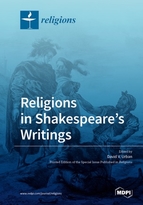Religions in Shakespeare's Writings
A special issue of Religions (ISSN 2077-1444).
Deadline for manuscript submissions: closed (10 June 2019) | Viewed by 79318
Special Issue Editor
Interests: Renaissance and seventeenth-century British literature (especially Milton and Shakespeare); American literature through the Civil War; modern drama; Bible as literature
Special Issue Information
Dear Colleagues,
Although Shakespeare is not primarily regarded as a religious writer, manifestations of religion abound in his plays, including but not limited to his depictions of Roman Catholic and Protestant Christianity, Islam, Judaism, religion in the Roman Republic, and aspects of ancient pagan religion that are used to articulate Christian themes. Any number of Shakespeare’s sonnets also address theological themes and put forward theological imagery. And Shakespeare’s multifaceted use of the Bible is evident throughout his writings.
In recent decades, increasing attention has been given to various manifestations of religion in Shakespeare’s writings. Book-length studies have investigated Shakespeare’s use of the Bible (e.g., Shaheen 1999, Marx 2000, Hamlin 2013) and the Book of Common Prayer (Swift 2012); Shakespeare’s engagement of Catholic, Anglican, and/or Puritan thought (Hunt 2004; Batson [ed.] 2006, Beauregard 2008); Shakespeare’s political theology (Lupton 2005); the theme of skeptical faith in Shakespeare’s writings (Cox 2007); and the theme of forgiveness in his plays (Beckwith 2011). Although Cox’s aforementioned investigation of skepticism ultimately argues that Christian affirmation undergirds Shakespeare’s canon, certain other recent forays into Shakespeare’s religious skepticism are less inclined to assert Shakespeare’s Christian grounding (Jackson and Marotti [eds.] 2011, Sterrett 2012). Meanwhile, the portrayal of Judaism in The Merchant of Venice—both in Shakespeare’s text and in particular performances of it—continues to generate critical controversy (see, for example, a series of recent articles in Shakespeare Bulletin), while scholarly discussion of Shakespeare and Islam gained momentum after a 2008 Special Issue on “Shakespeare and Islam” in the journal Shakespeare. Recently, a broader investigation of Shakespeare and Early Modern Religion appears in Loewenstein and Wittmore (eds.) 2015. And Kaufman 2013 emphasizes the various religious developments during Shakespeare’s lifetime that in turn manifested themselves in Shakespeare’s writings.
While respecting the assertions of individual contributors, this Special Issue on “Religions in Shakespeare’s Writings” will not attempt to present a Shakespeare whose particular religious beliefs can definitively be known or are displayed in a unified manner throughout his canon. Rather, it seeks to explore the gamut of religious issues and characterizations throughout Shakespeare’s writings, basing its analyses primarily on Shakespeare’s texts themselves even as it welcomes the use of other texts, contemporary to Shakespeare and otherwise, to elucidate such analyses. This Special Issue welcomes a variety of perspectives on and critical approaches to Shakespeare and religions, and it is our hope that by approaching Shakespeare’s works thus, we shall continue to explore this topic’s riches.
References
Beauregard, David N. Catholic Theology in Shakespeare’s Plays. Newark: University of Delaware Press, 2008.
Beckwith, Sarah. Shakespeare and the Grammar of Forgiveness. Ithaca, NY: Cornell University Press, 2011.
Batson, Beatrice, ed. Shakespeare and Christianity: The Protestant and Catholic Poetics of “Julius Caesar,” “Macbeth,” and “Hamlet.” Waco: Baylor University Press, 2006.
Cox, John D. Seeming Knowledge: Shakespeare and Skeptical Faith. Waco: Baylor University Press, 2007.
Hamlin, Hannibal. The Bible in Shakespeare. Oxford: Oxford University Press, 2013.
Hunt, Maurice. Shakespeare’s Religious Allusiveness: Its Play and Its Tolerance. Aldershot: Ashgate, 2004.
Jackson, Ken and Arthur Marotti, eds. Shakespeare and Religion. South Bend, IN: University of Notre Dame Press, 2011.
Kaufman, Peter Iver. Religion around Shakespeare. University Park: The Pennsylvania State University Press, 2013.
Loewenstein, David and Michael Witmore, eds. Shakespeare and Early Modern Religion. Cambridge: Cambridge University Press, 2015.
Lupton, Julia Reinhard. Citizen-Saints: Shakepeare and Political Theology. Chicago: University of Chicago Press, 2005.
Marx, Steven. Shakespeare and the Bible. Oxford: Oxford University Press, 2000.
Shaheen, Naseeb. Biblical References in Shakespeare’s Plays. Newark: University of Delaware Press, 1999.
Sterrett, Joseph. The Unheard Prayer: Religious Toleration in Shakespeare’s Drama. Leiden: Brill, 2012.
Swift, Daniel. Shakespeare’s Common Prayers: The Book of Common Prayer and the Elizabethan Age. Oxford: Oxford University Press, 2012.
Prof. Dr. David V. Urban
Guest Editor
Manuscript Submission Information
Manuscripts should be submitted online at www.mdpi.com by registering and logging in to this website. Once you are registered, click here to go to the submission form. Manuscripts can be submitted until the deadline. All papers will be peer-reviewed. Accepted papers will be published continuously in the journal (as soon as accepted) and will be listed together on the special issue website. Research articles, review articles as well as short communications are invited. For planned papers, a title and short abstract (about 100 words) can be sent to the Editorial Office for announcement on this website.
Submitted manuscripts should not have been published previously, nor be under consideration for publication elsewhere (except conference proceedings papers). All manuscripts are thoroughly refereed through a double-blind peer-review process. A guide for authors and other relevant information for submission of manuscripts is available on the Instructions for Authors page. Religions is an international peer-reviewed open access monthly journal published by MDPI.
Please visit the Instructions for Authors page before submitting a manuscript. Submitted papers should be well formatted and use good English. Authors may use MDPI's English editing service prior to publication or during author revisions.
Keywords
- Shakesepare
- Religion
- Religions
- Christianity
- Judaism
- Islam
- Bible
- Theology
- church






